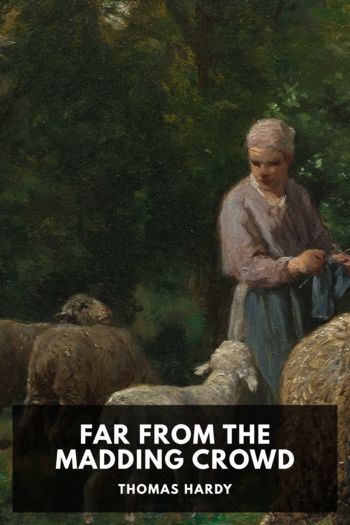
Description
Far from the Madding Crowd was Thomas Hardy’s fourth novel and was completed in 1874. It was originally serialized in Cornhill Magazine and was quickly published in a successful single volume.
Hardy described Wessex as “a merely realistic dream country” and so it is in Far from the Madding Crowd, where an idyllic view of the countryside is interrupted by the bitter reality of farming life. The novel is the first that Hardy sets in fictional Wessex; he quickly realised that setting novels there could be a money-earner that would subsidise his poetry-writing ambitions.
Gabriel Oak, the faithful man and aspiring farmer; Bathsheba Everdene, the young and independent lady farmer; William Boldwood, the lonely neighbour; and Sergeant Troy, the dashing military man, all lead intertwined lives which are full of love and loss.

Description
Grace Melbury, daughter of a rich local wood-trader, has been raised beyond her family through years of expensive education. Coming home, she finds herself pulled between her love for her childhood friend Giles Winterborne, and the allure of the enigmatic Doctor Fitzpiers. Giles and Edgar have their own admirers too, and the backdrop of the bucolic pastures and woodlands of an impressionistic take on south-west England provides the perfect setting for their story.
The Woodlanders was commissioned by Macmillan’s Magazine in 1884, and was serialized and later published as a novel in 1887. The story’s themes of infidelity and less-than-blissful marriage were unusual for the time and drew ire from campaigners, but on its publication it garnered immediate critical acclaim. Thomas Hardy later regarded it as the favorite of his stories, and it’s remained perennially popular as a novel and as a series of adaptations to theatre, opera and film.

Description
Jude the Obscure was first published in its complete form in 1895, just after finishing its serial run in Harper’s Magazine. At the time, its unconventional and somewhat scandalous themes earned it widespread criticism and condemnation. In the 1912 “Wessex Edition,” Hardy appended a postscript to the book’s preface in which he stated that the outrage ultimately abated with no lingering effect other than “completely curing me of further interest in novel-writing.” Indeed, Jude was to be Hardy’s last novel.
The story chronicles the life of Jude Fawley, an orphan boy of unremarkable birth or means, growing up in the small farming village of Marygreen in Hardy’s fictional version of Wessex, England. From an early age, Jude determines to chart the course of his life by the stars of learning and scholarship, but he very quickly discovers just how little interest the society of his time would take in the grand ambitions of a young man of so humble an origin. Without proper guidance and limited resources, his progress is slow and arduous. And when he discovers the existence of his cousin, the charming Sue Bridehead, it is nearly abandoned altogether in favor of an almost obsessive pursuit.
The novel proceeds to trace the lives of Jude and Sue as they become locked in a struggle both against themselves and the conventions of their times. Lofty ideals clash with harsh realities; grand pursuits fall prey to darker aspects of human nature. Characters are complex: at times spiteful, selfish, or self-destructive. Hardy, however, remains very subtle in his portrayal of these tragic figures and their flaws. The effect is to render them convincingly human. Ultimately, Jude is an unhappy tale of unfulfilled promise that is rarely told, and rarely told so well.

Description
Tess of the d’Urbervilles is said to be Thomas Hardy’s fictional masterpiece and is considered to be an important nineteenth century novel. It explores themes of love, sex, class and morality in an aching love story.
It initially appeared in a censored, serialised version in The Graphic in 1891 and was published in a single volume the following year. Early reviews were mixed, partly because of its challenge to Victorian sexual morals—it is now looked upon much more favorably.
Tess Durbeyfield is the oldest child of uneducated peasants who are given the impression that they may have noble blood, as their surname is a corruption of that of an extinct Norman family. When Tess participates in the village May Dance, she meets Angel, who stops to join the dance but notices Tess too late to dance with her. That night, Tess’s father gets too drunk to drive to the market, so she undertakes the journey herself. However, she falls asleep at the reins, and the family’s only horse encounters a speeding wagon and is fatally wounded. Tess feels so guilty over the consequences for the family that she agrees to try to claim kin with a rich widow who lives in a neighbouring town. The story traces Tess’s life through the following years.
The novel has been adapted for the stage, theatre, opera, cinema and television numerous times since its publication.

Description
Like many of Hardy’s novels, The Mayor of Casterbridge is set in the fictional county of Wessex in the mid 1800s. It begins with Michael Henchard, a young hay-trusser, drunk on rum, auctioning off his wife and baby daughter at a village fair. The next day, overcome with remorse, Henchard resolves to turn his life around. When we meet Henchard eighteen years later, temperance and hard work have made him wealthy and respectable. However, he cannot escape his past. His secret guilt, his pride, and his impulsive temper all serve to sabotage his good name.
The Mayor of Casterbridge was published in 1886, first as a magazine serial and then later that year as a book. It is perhaps most noteworthy for the psychological portrait of Michael Henchard, a tragic character who remains sympathetic while simultaneously being deeply flawed. Typical of other Hardy novels, it also vividly depicts life in the rural countryside at that time.